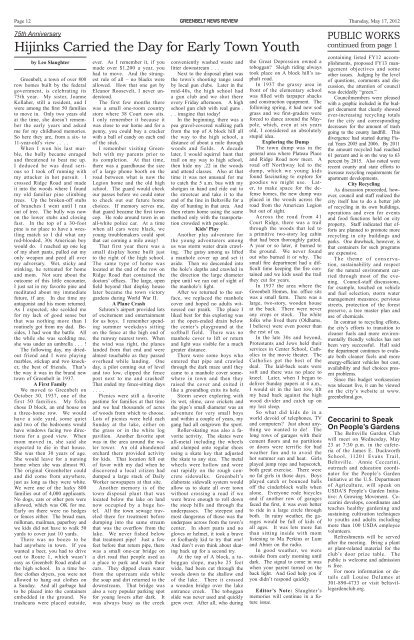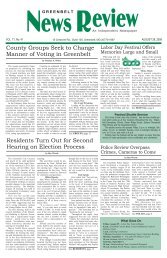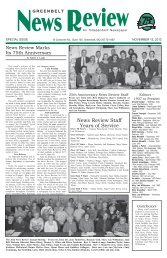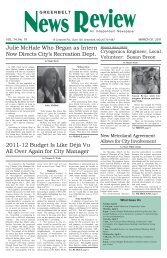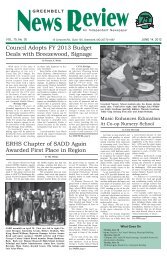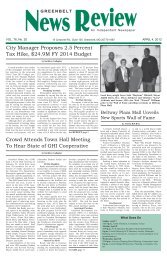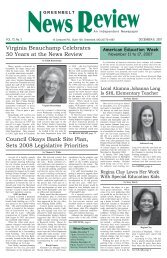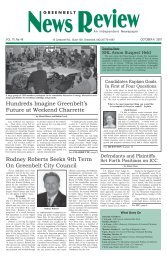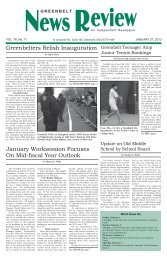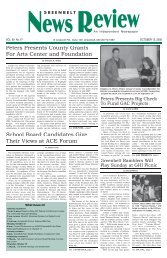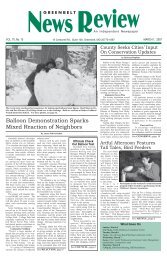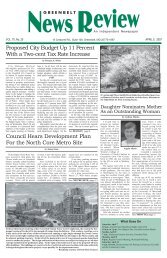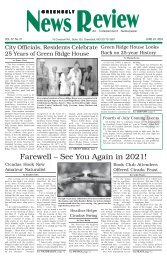Public Works Budget - Greenbelt News Review
Public Works Budget - Greenbelt News Review
Public Works Budget - Greenbelt News Review
You also want an ePaper? Increase the reach of your titles
YUMPU automatically turns print PDFs into web optimized ePapers that Google loves.
Page 12 GREENBELT NEWS REVIEW Thursday, May 17, 2012<br />
75th Anniversary<br />
Hijinks Carried the Day for Early Town Youth<br />
by Leo Slaughter<br />
<strong>Greenbelt</strong>, a town of over 800<br />
row homes built by the federal<br />
government, is celebrating its<br />
75th year. My sister, Joanne<br />
Kellaher, still a resident, and I<br />
were among the first 50 families<br />
to move in. Only two years old<br />
at the time, she doesn’t remember<br />
the early years and asked<br />
me for my childhood memories.<br />
So here they are, from a six- to<br />
11-year-old’s view . . . .<br />
When I won his last marble,<br />
the bully became enraged<br />
and threatened to beat me up.<br />
I deduced he was dead serious<br />
so I took off running with<br />
my attacker in hot pursuit. I<br />
crossed Ridge Road and made<br />
it into the woods where I found<br />
my old familiar pine climbing<br />
trees. Up the broken-off stubs<br />
of branches I went until I ran<br />
out of tree. The bully was now<br />
on the lower stubs and closing<br />
fast. In the top of a 30-foot<br />
pine is no place to have a wrestling<br />
match so I did what any<br />
red-blooded, 30s American boy<br />
would do. I reached up one leg<br />
of my short pants, pulled out my<br />
only weapon and peed all over<br />
my adversary. Wet, sticky and<br />
stinking, he retreated for home<br />
and mom. Not sure about the<br />
outcome of this little encounter,<br />
I just sat in my favorite pine and<br />
meditated about my immediate<br />
future, if any. In due time my<br />
antagonist and his mom returned.<br />
As I expected, she scolded me<br />
for my lack of good sense but<br />
that was nothing more than I<br />
routinely got from my dad. Besides,<br />
I had won the battle. All<br />
the while she was scolding me,<br />
she was under an umbrella . . . !<br />
The following day, my driedout<br />
friend and I were playing<br />
marbles, stickup and two knocker,<br />
the best of friends. That’s<br />
the way it was in the brand new<br />
town of <strong>Greenbelt</strong> in 1937.<br />
A First Family<br />
We moved to <strong>Greenbelt</strong> on<br />
October 30, 1937, one of the<br />
first 50 families. My folks<br />
chose D block, an end house on<br />
a three-home row. We would<br />
have a side yard, some quiet<br />
and two of the bedrooms would<br />
have windows facing two directions<br />
for a good view. When<br />
mom moved in, she said she<br />
expected to die in that house.<br />
She was then 30 years of age.<br />
She would leave for a nursing<br />
home when she was almost 90.<br />
The original <strong>Greenbelt</strong>er could<br />
and did come from anywhere,<br />
just as long as they were white.<br />
We were one of the lucky 800<br />
families out of 4,000 applicants.<br />
No dogs, cats or other pets were<br />
allowed, which was OK for me.<br />
Early on there were no hedges<br />
or fences either. The bread man,<br />
milkman, mailman, paperboy and<br />
we kids did not have to walk 50<br />
yards to cover just 10 yards.<br />
There was no booze to be<br />
had anywhere in town. If you<br />
wanted a beer, you had to drive<br />
out to Route 1, which wasn’t<br />
easy as <strong>Greenbelt</strong> Road ended at<br />
the high school. In a time before<br />
clothes dryers, you were not<br />
allowed to hang out clothes on<br />
a Sunday. And all garbage had<br />
to be placed into the containers<br />
embedded in the ground. No<br />
trashcans were placed outside,<br />
ever. As I remember it, if you<br />
made over $1,200 a year, you<br />
had to move. And the strangest<br />
rule of all – no blacks were<br />
allowed. How that one got by<br />
Eleanor Roosevelt, I never understood.<br />
The first few months there<br />
was a small one-room country<br />
store where 38 Court now sits.<br />
I only remember it because it<br />
was close to our home and for a<br />
penny, you could buy a cracker<br />
with a ball of candy on each end<br />
of the stick.<br />
I remember visiting <strong>Greenbelt</strong><br />
with my parents prior to<br />
its completion. At that time,<br />
there was a guardhouse the size<br />
of a large phone booth on the<br />
road between what is now the<br />
Legion home and the old high<br />
school. The guard would check<br />
our passes before we could enter<br />
to check out our future home<br />
choices. If memory serves me,<br />
that guard became the first town<br />
cop. He rode around town in an<br />
all-white police car. At a time<br />
when all cars were black, we<br />
young troublemakers could spot<br />
that car coming a mile away!<br />
That first year there was a<br />
small display home built just<br />
to the right of the high school.<br />
The same type of home was<br />
located at the end of the row on<br />
Ridge Road that contained the<br />
doctors’ offices. The large, open<br />
field beyond that display house<br />
later became the town victory<br />
gardens during World War II.<br />
A Plane Crash<br />
Schrom’s airport provided lots<br />
of excitement and entertainment<br />
for us boys. I remember spending<br />
summer weekdays sitting<br />
on the fence at the high end of<br />
the runway nearest town. When<br />
the wind was right, the planes<br />
landed from that end and were<br />
almost touchable as they passed<br />
overhead while landing. One<br />
day, a pilot coming out of level<br />
and too low, clipped the fence<br />
post next to me and crashed!<br />
That ended my fence-sitting days<br />
. . . .<br />
Picnics were still a favorite<br />
pastime for families at that time<br />
and we had thousands of acres<br />
of woods from which to choose.<br />
Lots of picnics were held each<br />
Sunday at the lake, either on<br />
the grass or in the white log<br />
pavilion. Another favorite spot<br />
was in the area around the water<br />
tower. An old abandoned<br />
orchard there provided activity<br />
for kids. That location fell out<br />
of favor with my dad when he<br />
discovered a local citizen had<br />
dumped a large stack of Daily<br />
Worker newspapers at that site.<br />
Another memory is of the<br />
town disposal plant that was<br />
located below the lake on land<br />
now occupied by a huge hotel.<br />
All the town sewage traveled<br />
there for treatment before<br />
dumping into the same stream<br />
that was the overflow from the<br />
lake. We never fished below<br />
that treatment pipe! Just a few<br />
feet before that return pipe, there<br />
was a small one-car bridge on<br />
a dirt road that people used as<br />
a place to park and wash their<br />
cars. They dipped clean water<br />
from the upstream side while<br />
the soap and dirt returned to the<br />
downstream. That bridge was<br />
also a very popular parking spot<br />
for young lovers after dark. It<br />
was always busy as the creek<br />
conveniently washed waste and<br />
litter downstream . . . .<br />
Next to the disposal plant was<br />
the town’s shooting range used<br />
by local gun clubs. Later in the<br />
mid-40s, the high school had<br />
a gun club and we shot there<br />
every Friday afternoon. A high<br />
school gun club with real guns .<br />
. . imagine that today!<br />
In the beginning, there was a<br />
pea gravel-covered walking path<br />
from the top of A block hill all<br />
the way to the high school, a<br />
distance of about a mile through<br />
woods and fields. A decade<br />
later, I would squirrel hunt that<br />
trail on my way to high school,<br />
then hide my .22 in the woods<br />
and attend classes. Also at that<br />
time it was not unusual for me<br />
to catch the 5 a.m. bus with my<br />
shotgun in hand and ride out to<br />
the streetcar and take it to the<br />
end of the line in Beltsville for a<br />
day of hunting in that area. And<br />
then return home using the same<br />
method only with the transportation<br />
crowded with people.<br />
Kids’ Play<br />
Another play adventure for<br />
the young adventurers among<br />
us was storm water drain crawling.<br />
The gutsy among us lifted<br />
a manhole cover up and set it<br />
aside. Then we descended into<br />
the hole’s depths and crawled in<br />
the direction the large diameter<br />
pipe until we ran out of sight of<br />
the manhole’s light.<br />
After we returned to the surface,<br />
we replaced the manhole<br />
cover and hoped no adults witnessed<br />
our prank. The place I<br />
liked best for this exploring was<br />
at the open-ended drain below<br />
the center’s playground at the<br />
softball field. There was no<br />
manhole cover to lift or return<br />
and light was visible for a much<br />
greater distance.<br />
There were some boys who<br />
entered that pipe and crawled<br />
through the dark maze until they<br />
came to a manhole cover somewhere<br />
in town and then they<br />
raised the cover and exited it<br />
like a groundhog exits its hole.<br />
Storm sewer exploring with<br />
its wet, slime, cave crickets and<br />
the pipe’s small diameter was an<br />
adventure for very small boys<br />
and within a couple of years, my<br />
gang had all outgrown the sport.<br />
Roller-skating was also a favorite<br />
activity. The skates were<br />
all-metal including the wheels<br />
and clamped onto regular shoes<br />
using a skate key that adjusted<br />
the skate to any size. The metal<br />
wheels were hollow and wore<br />
out rapidly on the rough concrete<br />
sidewalks. <strong>Greenbelt</strong>’s<br />
elaborate sidewalk system would<br />
allow us to skate all over town<br />
without crossing a road if we<br />
were brave enough to roll down<br />
the steep hills and through the<br />
underpasses. The steepest and<br />
most dangerous of those was the<br />
underpass across from the town’s<br />
center. In short pants and no<br />
gloves or helmet, it took a brave<br />
or foolhardy kid to try that one!<br />
And don’t even think about skating<br />
back up for a second try.<br />
At the top of A block, a toboggan<br />
slope, maybe 25 feet<br />
wide, had been cut through the<br />
woods down to the shallow end<br />
of the lake. There it crossed<br />
a wooden bridge over the lake<br />
entrance creek. The toboggan<br />
slide was never used and quickly<br />
grew over. After all, who during<br />
the Great Depression owned a<br />
toboggan? Sleigh riding always<br />
took place on A block hill’s asphalt<br />
road.<br />
In 1937 the grassy area in<br />
front of the elementary school<br />
was filled with tarpaper shacks<br />
and construction equipment. The<br />
following spring, it had new sod<br />
grass and we first-graders were<br />
forced to dance around the Maypole,<br />
which, even at six years<br />
old, I considered an absolutely<br />
stupid idea.<br />
Exploring the Dump<br />
The town dump was in the<br />
general area where Plateau Place<br />
and Ridge Road now meet. A<br />
road off Northway led to the<br />
dump, which we young kids<br />
found fascinating to explore for<br />
goodies we might use. Later,<br />
to make space for the defense<br />
homes, the new dump was<br />
placed in the woods across the<br />
road from the American Legion<br />
but out of sight.<br />
Across the road from 41<br />
Court Ridge, there was a trail<br />
through the woods that led to<br />
a primitive two-story log cabin<br />
that had been thoroughly gutted.<br />
A year or so later, it burned to<br />
the ground. We never found<br />
out who burned it or why. The<br />
small fire department had a difficult<br />
time keeping the fire contained<br />
and we kids used the trail<br />
they cut for years.<br />
In 1937 the area where the<br />
<strong>Greenbelt</strong> Homes, Inc. office sits<br />
was a small farm. There was a<br />
large, two-story, wooden house<br />
at the back. There were never<br />
any crops or stock. The white<br />
folks who lived there (Oldhams,<br />
I believe) were even poorer than<br />
the rest of us.<br />
In the late 30s and beyond,<br />
Protestants and Jews held their<br />
services in Center School, Catholics<br />
in the movie theater. The<br />
Catholics got the best of the<br />
deal. The laid-back seats were<br />
soft and there was no place to<br />
kneel. Later, when I began to<br />
deliver Sunday papers at 4 a.m.,<br />
I would sit in the last row, tilt<br />
my head back against the high<br />
wood divider and catch up on<br />
my lost sleep.<br />
So what did kids do in a<br />
world devoid of telephones, TV<br />
and computers? Just about anything<br />
we wanted to do! The<br />
long rows of garages with their<br />
cement floors and no partitions<br />
or doors were terrific for bad<br />
weather fun and to avoid the<br />
hot summer sun and heat. Girls<br />
played jump rope and hopscotch,<br />
both great exercise. There were<br />
no fat girls in those days. Boys<br />
played catch or bounced balls<br />
off the cinderblock walls when<br />
alone. Everyone rode bicycles<br />
and if another row of garages<br />
faced the first, it was even better<br />
to ride in a large circle through<br />
both. In rainy weather, the garages<br />
would be full of kids of<br />
all ages. It was lots more fun<br />
than sitting inside with mom<br />
listening to Ma Perkins or Lum<br />
and Abner on the radio.<br />
In good weather, we were<br />
outside from early morning until<br />
dark. The signal to come in was<br />
when your parent turned on the<br />
back light. And God help you if<br />
you didn’t respond quickly.<br />
Editor’s Note: Slaughter’s<br />
memories will continue in a future<br />
issue.<br />
PUBLIC WORKS<br />
continued from page 1<br />
containing listed FY12 accomplishments,<br />
proposed FY13 management<br />
objectives and some<br />
other issues. Judging by the level<br />
of questions, comments and discussion,<br />
the attention of council<br />
was decidedly “green.”<br />
Councilmembers were pleased<br />
with a graphic included in the budget<br />
document that clearly showed<br />
ever-increasing recycling totals<br />
for the city and corresponding<br />
decreases for the amount of trash<br />
going to the county landfill. This<br />
divergence had started during Fiscal<br />
Years 2005 and 2006. By 2011<br />
the amount recycled had reached<br />
61 percent and is on the way to 63<br />
percent by 2015. Also noted were<br />
recent county and state efforts to<br />
increase recycling requirements for<br />
apartment developments.<br />
City Recycling<br />
As discussion proceeded, however,<br />
council and staff realized the<br />
city itself has to do a better job<br />
of recycling in its own buildings,<br />
operations and even for events<br />
and food functions held on city<br />
property. Staff indicated that efforts<br />
are planned to promote more<br />
recycling in city buildings and<br />
parks. One drawback, however, is<br />
that containers for such programs<br />
are expensive.<br />
The theme of conservation,<br />
sustainability and respect<br />
for the natural environment carried<br />
through most of the evening.<br />
Council-staff discussions,<br />
for example, touched on vehicle<br />
and fuel selection, storm water<br />
management measures, pervious<br />
streets, protection of the forest<br />
preserve, a tree master plan and<br />
use of chemicals.<br />
In contrast to recycling efforts,<br />
the city’s efforts to transition to<br />
cleaner fuels and more environmentally<br />
friendly vehicles has not<br />
been very successful. Hall said<br />
the department continues to evaluate<br />
both cleaner fuels and more<br />
energy-efficient vehicles but cost,<br />
availability and fuel choices present<br />
problems.<br />
Since this budget worksession<br />
was telecast live, it can be viewed<br />
on the city’s website at www.<br />
greenbeltmd.gov.<br />
Ceccarini to Speak<br />
On People’s Gardens<br />
The Beltsville Garden Club<br />
will meet on Wednesday, May<br />
23 at 7:30 p.m. in the cafeteria<br />
of the James E. Duckworth<br />
School, 11201 Evans Trail,<br />
Beltsville. Annie Ceccarini,<br />
outreach and education coordinator<br />
for the People’s Garden<br />
Initiative at the U.S. Department<br />
of Agriculture, will speak on<br />
USDA’S People’s Garden Initiative:<br />
A Growing Movement. Ceccarini<br />
develops, coordinates and<br />
teaches healthy gardening and<br />
sustaining cultivation techniques<br />
to youths and adults including<br />
more than 100 USDA employee<br />
volunteers.<br />
Refreshments will be served<br />
after the meeting. Bring a plant<br />
or plant-related material for the<br />
club’s door prize table. The<br />
public is welcome and admission<br />
is free.<br />
For more information or details<br />
call Louise DeJames at<br />
301-890-4733 or visit beltsvillegardenclub.org.


